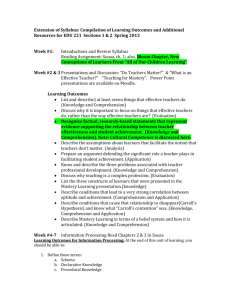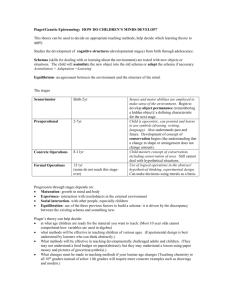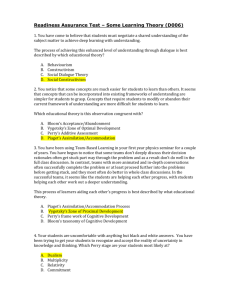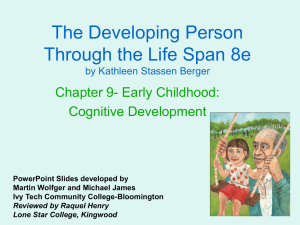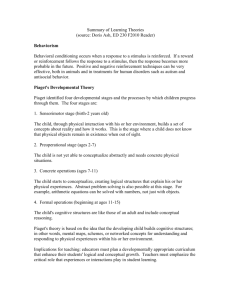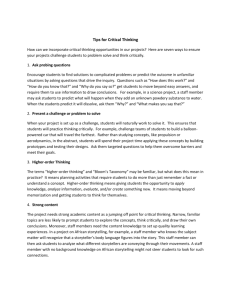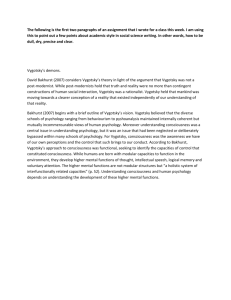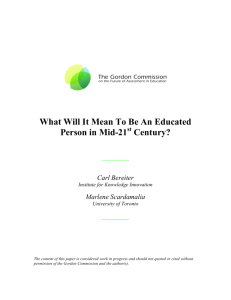How to Promote Higher-Order Thinking in the Classroom
advertisement
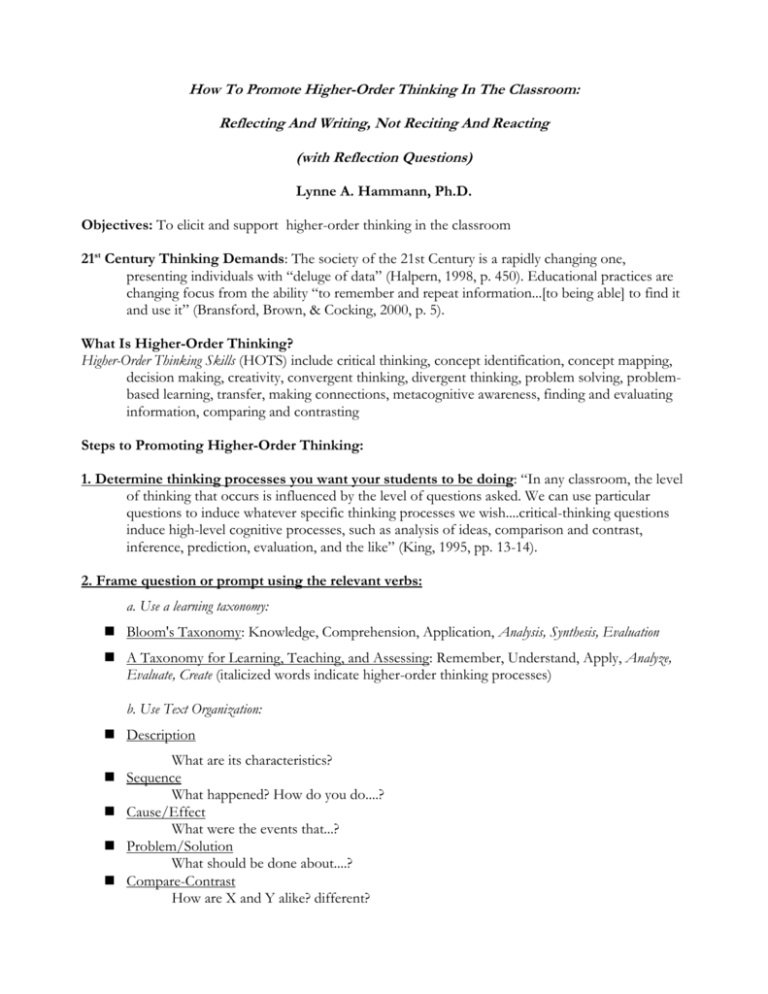
How To Promote Higher-Order Thinking In The Classroom: Reflecting And Writing, Not Reciting And Reacting (with Reflection Questions) Lynne A. Hammann, Ph.D. Objectives: To elicit and support higher-order thinking in the classroom 21st Century Thinking Demands: The society of the 21st Century is a rapidly changing one, presenting individuals with “deluge of data” (Halpern, 1998, p. 450). Educational practices are changing focus from the ability “to remember and repeat information...[to being able] to find it and use it” (Bransford, Brown, & Cocking, 2000, p. 5). What Is Higher-Order Thinking? Higher-Order Thinking Skills (HOTS) include critical thinking, concept identification, concept mapping, decision making, creativity, convergent thinking, divergent thinking, problem solving, problembased learning, transfer, making connections, metacognitive awareness, finding and evaluating information, comparing and contrasting Steps to Promoting Higher-Order Thinking: 1. Determine thinking processes you want your students to be doing: “In any classroom, the level of thinking that occurs is influenced by the level of questions asked. We can use particular questions to induce whatever specific thinking processes we wish....critical-thinking questions induce high-level cognitive processes, such as analysis of ideas, comparison and contrast, inference, prediction, evaluation, and the like” (King, 1995, pp. 13-14). 2. Frame question or prompt using the relevant verbs: a. Use a learning taxonomy: Bloom's Taxonomy: Knowledge, Comprehension, Application, Analysis, Synthesis, Evaluation A Taxonomy for Learning, Teaching, and Assessing: Remember, Understand, Apply, Analyze, Evaluate, Create (italicized words indicate higher-order thinking processes) b. Use Text Organization: Description What are its characteristics? Sequence What happened? How do you do....? Cause/Effect What were the events that...? Problem/Solution What should be done about....? Compare-Contrast How are X and Y alike? different? Prompt Examples Compare and contrast the cognitive theories of Piaget and Vygotsky. (analysis). Construct a lesson plan that includes both Piaget's and Vygotsky's theory (synthesis). Choose the three most important concepts from either Piaget's or Vygotsky's theories (evaluation). Create a lesson plan for your learners' age and content area that includes Piaget's and Vygotsky's theories as well as meets appropriate professional standard(s) (create). 3. Construct the learning activity: formal paper, informal/in-class reflection paper, small group activity to report or create "visual" and share; think-pair-share; large-group concept map, largegroup chart. Learning Activities Each small group will construct a concept map paper to show the three most important concepts from Piaget's or Vygotsky's theories. Concept maps will be constructed on large newprint sheets and taped on the board with sides slightly overlapping. Each small group will share the reflecting and reasons, explaining the maps. Then students will volunteer (be called on) to identify and mark connections among the maps from at least two different groups. Students will complete a large chart on the board (or on newsprint) with the following headings: Age of learners, content area, Piaget's Theory Concept, Vygotsky's Theory Concept. Learning Outcomes Learners will be engaged in active learning (e.g.,) knowledge-transforming, knowledgeconstruction, concept formation. Learners will use prior knowledge and connect with information they are learning to make new knowledge (Bereiter & Scardamalia, 1987). Learners will become "more active builders of their own knowledge in all domains” (Bereiter & Scardamalia, 1987, p. 363). For further questions, please contact Lynne A. Hammann, Ph.D. Department of Education & Special Education 203C Retan Center, 662-4561 Mansfield University lhammann@mansfield.edu References Anderson, L. W. and Krathwohl, D. R. (2001). A taxonomy for learning, teaching, and assessing: A revision of Bloom’s Taxonomy of Educational Objectives. New York: Longman. Bereiter, C., and Scardamalia, M. (1987). The psychology of written composition. Hillsdale, NJ: Lawrence Erlbaum, Publishers. Bransford, J., Brown, A.. L., and Cocking, C. R. (Eds.). (2001). How people learn: Brain, mind, experience, and school. Washington, D.C: National Academy Press. Bruning, R.H, Schraw, G.J, and Ronning, R.R. (1991). Cognitive psychology and instruction (3rd ed.). Columbus, OH: Prentice-Hall. Halpern, D.F. (1998). Teaching critical thinking for transfer across domains: Dispositions, skills, structure training, and metacognitive monitoring. American Psychologist, 53, 449-455. Hammann, L. A. (2005). Reflecting and Writing, Not Reacting and Reciting: Promoting Higher-Order Thinking in the Classroom. Presented at Thirth-Fifth Annual Conference of The International Society for Exploring Teaching and Learning, Cocoa Beach, FL, October, 2005. King, A. (1995). Inquiring minds really do want to know: Using questioning to teach critical thinking, Teaching of Psychology, 22, 13-17. Santrock, J. W. (2001, 2004). Educational Psychology (2nd ed.). New York: McGraw-Hill. REFLECTION QUESTIONS “In any classroom, the level of thinking that occurs is influenced by the level of questions asked. We can use particular questions to induce whatever specific thinking processes we wish....Critical-thinking questions activate critical thinking in both the questioner and the responder. More specifically, criticalthinking questions induce high-level cognitive processes, such as analysis of ideas, comparison and contrast, inference, prediction, evaluation, and the like” (King, 1995, pp. 13-14). 1. What question(s) do you still have after reading this chapter? Explain why the answer(s) to this are important. 2. Write a one-page summary of the chapter (own words). After the summary, explain how the information in this chapter fits into the “big picture” of educational psychology. Explain briefly (1/2 page) how/why this strategy can support learning. 3. Identify and discuss one new thing you learned from this chapter. Explain why an accurate understanding of this is important. 4. Identify and discuss or one misconception that you had. Explain why an accurate understanding of this misconception is important. 5. Rank the three most important concepts in this chapter. Explain why, as well as why you have chosen this ranking. 6. Discuss a connection that you see between a concept in this chapter and a concept from a previous chapter, including implications for your future practice. 7. What did you find in this chapter that you could use and/or apply to yourself as a learner? 8. What is the most important finding or conclusion from research study/set of studies in the chapter? Explain why. 9. Choose one of the Danielson domains and explain why/how the concepts in this chapter relate to it (may be used twice with two different domains/standards). 10. What research/concept/point(s) in this chapter should be required reading for all teachers? Explain why. 11. What research/concept/point(s) in this chapter should be required reading for all parents? Explain why. 12. What research/concept/point(s) in this chapter should be required reading for all administrators? Explain why. 13. What research/concept/point(s) in this chapter should be required reading for all learners? Explain why. 14. What reflection question/critical thinking question is not on this list that you would like to answer? Write the question and the answer, explaining why this question is important.

